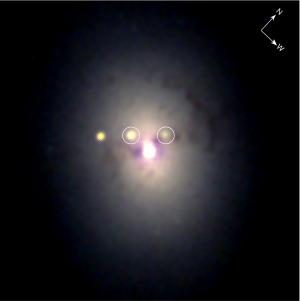Twin Star Explosions

_______________________________________________________
(Credit: NASA/Swift/Stefan Immler) using NASA's Swift satellite
Scientists using NASA's Swift satellite stumbled upon a rare sight: two supernovas side by side in one galaxy. Large galaxies typically play host to three supernovas per century. Galaxy NGC 1316 has had two supernovas in less than five months, and a total of four supernova in 26 years, as far back as the records go. This makes NGC 1316 one of the most prodigious known producer of supernovas.
An image of the two supernovas side by side in the galaxy NGC 1316 is pictured here. The first supernova, still visible on the "right" in the image, was detected on June 19, 2006, and was named SN 2006dd. The second supernova, on the immediate "left" in the image, was detected on November 5 and has been named SN 2006mr. (Other objects in the image include a central bright spot, which is the galaxy core, and a bright object to the far left, like an earring, which is a foreground star.)
NGC 1316, a massive elliptical galaxy about 80 million light years way, has recently merged with a spiral galaxy. Mergers do indeed spawn supernovas by forcing the creation of new, massive stars, which quickly die and explode. Yet all four supernovas in NGC 1316 appear to be Type Ia, a variety previously not associated with galaxy mergers and massive star formation. Scientists are intrigued and are investigating whether the high supernova rate is a coincidence or a result of the merger.
Swift was launched two years ago, on 20 November 2004, was fully operational by January 2005, and since then has observed more than 200 gamma-ray bursts plus more than a thousand other astronomical objects.
Penn State edu - Swift alert 21st Nov 2006
_______________________________________________________
More to starlight than meets the Eye
_______________________________________________________

_______________________________________________________
Image courtesy of Clemson University
The solar system is located at the outskirts of a majestic spiral galaxy, like the one shown in this simulated image. While it is difficult to obtain such an image from our inside location, many astronomical observations indicate that the picture shown here is a good representation.
Star counts in the infrared part of the electromagnetic spectrum with NASA's recently launched Spitzer Space Telescope led to this image, which shows that the central region has a large bar (also seen in many distant spiral galaxies) and pronounced spiral arms. Much of the star formation traced by the gamma-rays from 26-aluminum originates in stellar explosions (supernovae) that quickly follow the formation of massive stars along these spiral arms. As the spiral pattern rotates through the gas in a galaxies disk, the most massive stars light up the galaxy and seed the gas with freshly synthesized elements that are so essential to the evolution of life.
Where do elements, such as iron in our blood or calcium in our bones, come from? Astronomers say they come from thermonuclear reactions in hundreds of millions of stars that burn at high temperatures in our galaxy. Stars that are 10 or more times more massive than the sun eventually explode as supernovas, leaving traces of elements in the space between the stars of the Milky Way. When our solar system was created, astronomers say the trace elements were drawn from interstellar gases to form the Earth.
“Life depends on stars creating elements we so desperately need,” says Clemson University astrophysicist Dieter Hartmann. “It’s these elements that support life here on Earth and probably elsewhere.”
Read more >>> Science Daily release
_______________________________________________________
_______________________________________________________
Time is of your own making; its clock ticks in your head.
The moment you stop thought time too stops dead. Angelus Silesius
_______________________________________________________
_______________________________________________________
Labels: NASA, Supernovae, Swift


<< Home